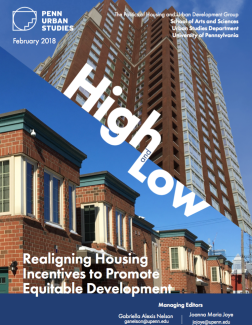
Philadelphia’s generous ten-year property tax abatement has been a catalyst for wealth-building, primarily in strong downtown and neighborhood real estate markets for two decades. Can this incentive now also become a vehicle for supporting equitable development across the city?
Lecturer John Kromer and a group of students in his “Politics of Housing and Urban Development” class researched a dozen years’ worth of data files to explore this issue during fall semester 2017. Their findings are published in a new report, High and Low: Realigning Housing Incentives to Promote Equitable Development.
Students in John Kromer’s class examined two related questions: Who benefits most from Philadelphia’s residential tax abatement—the public at large or a relatively small group of wealthy investors and developers? And can the city’s tax abatement policy be revised to provide broader benefit than was possible twenty years ago when this incentive was first introduced?
As documented in their research report, High and Low: Realigning Housing Incentives to Promote Equitable Development, the answer to the first question is “Both.” Although the biggest individual beneficiaries of the tax abatement are the owners of residential properties in Philadelphia’s strongest real estate markets, the biggest group of residential properties that have benefitted from the tax abatement are buildings that have been developed for less than $500,000 and that can be found in every area of the city.
The report includes an analysis of twelve years’ worth of data on tax abatements awarded to thousands of new and rehabilitated housing units--nearly 14,000 in the current tax year alone. The group also examined the pros and cons of several scenarios for recapturing some of the tax revenue currently withheld from the City and School District for a decade (based on the current tax abatement policy) and reallocating it in order to generate new resources for affordable housing and public education.
The Philadelphia City Controller's Office subsequently used the report as a primary information source for its own analysis of the tax abatement, published a few months later. The COntroller's Director of Strategy and Policy Analysis termed the report, "one of the most helpful resources I've looked at since starting work on this topic."
